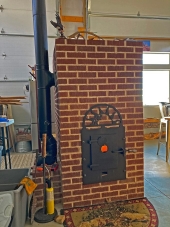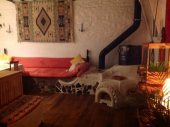paul wheaton wrote:I think an enclosed porch for the front door would probably help a lot too.
My home needs that also!
I find it crazy that homes in colder climates are built without enclosed porches. Don't need to heat them, but to act as an airlock is very important.
paul wheaton wrote:In another thread, there were people who cast doubts on how little wood it would take to heat a three bedroom montana home.
Frankly, I'm getting kinda sick of proving shit.
Here's what how I think of it.
If the TechnoNerds want to compare, then use the standard density for the wood Paul mentioned he burns, and then compare that to the wood YOU burn.
I have access to spruce, jackpine, (Black/White)poplar/alder/dogwood/aspen (around here, everyone calls them something different, but we really don't know what they are), some birch, LOTS of willow.
Everyone burns jackpine or poplar. It is cheap, plentiful. Pine is hotter than poplar, but so what, we have so much, it matters little, other than you stoke 20% more. We leave the birch for the wealthy.
Now if I want to compare, as Paul did, I would use the wood I normally use. Simple. And if someone needed to compare, use the standard weights, and convert to their wood.
Just like comparing oil, electricity, propane, LNG. it is all BTU.
Paul heated his home with about 11.2MBtu of available energy. That is what HIS house/location required. and each home is specific. Mine might be more or less insulated/sealed up than his.
Remember, in NYC, the skyscraping office buildings have NO heat source. An example of specifics.
Now as for proving... just have someone measure the temp/cfm of the exhaust of the RMH vs the efficient wood stove, and you will see WHERE the efficiency lay. From that, and knowing the available BTU of wood, you can tell how much energy is being kept in the home. If you can hold your hand/face in the exhaust of a RMH, that means most heat is left inside. I know folks who COOK inside the stacks of a modern wood stove.... a LOT of heat goes out the chimney.
if a RMH has cool exhaust, it is reasonable to assume the "energy" is in the house!
as energy is a constant, we can then understand that by knowing the exhaust temps and the available BTU of wood, we can see how much/little heat loss there is, and THAT will PROVE the hypothesis that a RMH is far more efficient than a wood stove, oil furnace, LNG/Propane furnace, or electric heat.
My question is:
Can one RMH heat a modern house, basement and main floor, in Central Saskatchewan winter?
I laugh when folks say "It got cold last night... -17F! My idea of cold is -35 to -45. C or F, it don't matter.... it is dang cold.
I think we need to compare "heating degree days" at each site to get a feel for how it compares at different locations.
Would I need to have a fire twice a day?
my oil consumption equals 2500Lx34kbtu= aprox 85 MBtu X 50% efficiency (OLD furnace, should be replaced) = 42.5MBtu needed to heat my house
To replace that, I would need to burn at 100% efficiency, 2.3 cords of jackpine, or 2.8 cords of white poplar/aspen
so, looking at Paul's experiment, using 0.56 cords in his warm winter location, I think Paul's numbers make sense.
just to give you some comparisons. a friend has an outdoor boiler for hot water heat. he burns 15 cords of Jackpine a winter. A neighbour has a Valley Comfort Stove in his basement, burns 5 cords of Jackpine, and 45gal of heating fuel in his backup. I burn 2500 liters of oil in my furnace.
I have an issue with insurance, so can't have wood heat yet, but am working on it.
I am still trying to figure out what system is best for me. a RMH on the main floor is out, unless we build on.
Something in the basement that requires only TWO tendings per day, would be best, I think.







 1
1








 1
1


























